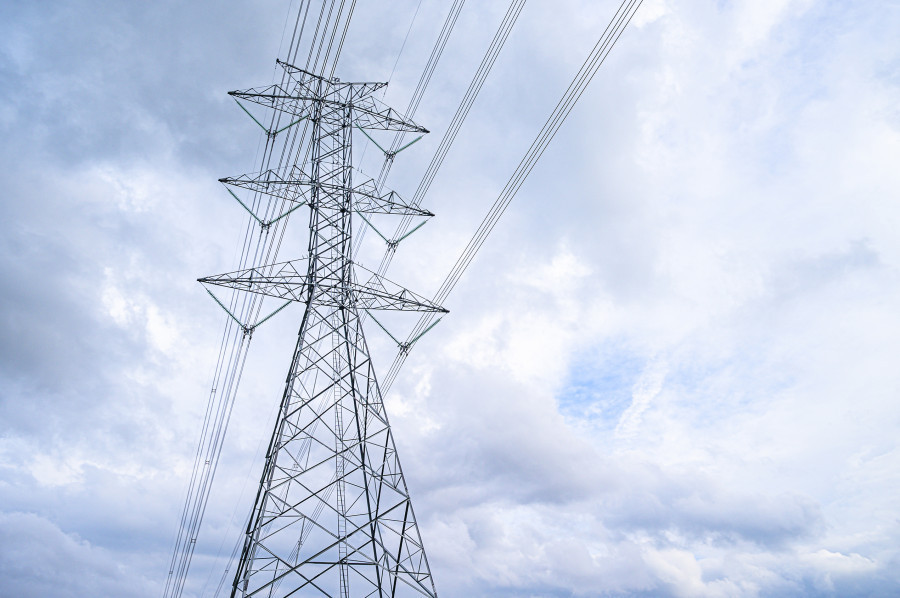National
Stalled Bharatpur-Bardaghat transmission line work finally resumes
The Nepal Electricity Authority moved ahead to construct the remaining two pylons, but some locals have yet to accept the compensation for their land.
Prithvi Man Shrestha
The state-owned Nepal Electricity Authority (NEA) has started work on constructing two remaining transmission towers of the Bharatpur-Bardaghat transmission line project, nearly a year after the Supreme Court cleared the way for the power utility to continue work on the project.
The Supreme Court on June 27 last year had allowed the NEA to carry out the remaining works in the project by vacating an interim order issued earlier.
A long-running obstruction by locals at the pylon-erection site in the Dumkibas area in Binaya Tribeni Rural Municipality of Nawalparasi (East of Susta) continued even after last year’s Supreme Court order.
Earlier, the project’s work had stalled for more than a year after the Supreme Court, acting on a writ petition filed by the locals, issued an interim order in April 2021 to stop work on the two last pylons.
“Since late May, work on the remaining task of the Bharatpur-Bardaghat transmission line has begun,” said Dirghayu Kumar Shrestha, chief of the transmission directorate at NEA. “We are preparing the foundation of a transmission tower and we will erect another after completing the first one.”
According to NEA, after erecting two transmission towers, a power line should be connected on those towers and the project will be ready for the evacuation of power.
Even though the NEA had offered improved compensation after conducting a fresh evaluation of the lands and properties to be acquired, not all locals have accepted the compensation package yet. “We are carrying out the work after taking protection from the security agencies,” said Shrestha.
However, it is not that the police protection was taken because locals had obstructed the work. “Without reaching consensus on compensation with all the locals, we have started the construction work,” said Santosh Sah, chief of the transmission line project. “We plan to complete the work within a month.”
According to Sah, more than 90 percent of locals of Dumkibas area whose lands will be affected by the project have agreed to accept the improved compensation.
“Some locals are only concerned about how much compensation they will be paid for houses, huts and cash crops to be damaged by the projects in addition to the compensation for their lands,” he said.
Earlier, the NEA had decided to be flexible on compensation to end the dispute. Particularly in the case of this project, the NEA had decided to provide compensation of as much as 50 percent of the value of the land. But those landowners who will lose around 75 percent of their property to the transmission line will be qualified to get compensation only up to 50 percent of the value of the land.
Likewise, those who will lose between 50 percent and 75 percent of their lands will get 40 percent of the value as compensation, as per the criteria set by NEA. The land owners losing lands between 25 percent and 50 percent of their total land will get 30 percent of the value as compensation, and those losing less than 25 percent will be paid 20 percent of the value of their land as compensation.
The power utility does not acquire the land that falls under the transmission line, but has a policy of providing 20 percent of the value of the land as compensation. “In the case of this specific area, compensation has been determined in a way that most of the land owners would get in the range of 40 percent to 50 percent of the value of the lands,” Sah had told the Post previously.
The NEA will provide such compensation for the lands that fall within 15 metres on either side of the transmission line.
The Bharatpur-Bardaghat Transmission Line is one of the many transmission line projects that has faced obstruction from the locals.
According to NEA, it has already erected 244 of the 246 pylons of the 74-km transmission line. Completion of this 220kV power line is vital to the supply of power to the western part of the country from the east, which would help reduce power imports from India through the bordering Tanakpur area of India.
The existing 132 kV Bharatpur-Bardaghat transmission line connecting the country’s eastern region with the western side has been making it difficult to supply large quantities of power from one area to another, according to the NEA. The line can carry a maximum of 80 megawatts.
The NEA said developing high-capacity power lines across the country is vital to ensuring a reliable power supply across the country and an uninterrupted cross-border power trade.




 19.12°C Kathmandu
19.12°C Kathmandu















